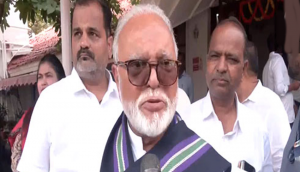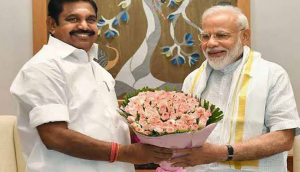Don't understand why Rohingyas want recognition as separate ethnic group: VS Seshadri

Prime Minister Narendra Modi will be in Nay Pyi Taw, the capital of Myanmar on Tuesday on his first bilateral visit to the Eastern neighbour. He was last there for the India ASEAN Summit. Since then things have changed for Myanmar, it has seen a change in political leadership and the National League for Democracy (NLD) government has come into power.
Former Ambassador to Myanmar VS Seshadri says the time is ripe for Modi to be in Myanmar. This year marks 70 years of diplomatic relations between India and Myanmar and 25 years of the India ASEAN friendship agreement.
Modi has invited ASEAN leaders for the 2018 Republic Day. And that if you look East it is Myanmar first.
And all of this adds up to the fact that Modi is visiting Myanmar at a critical time when attacks in Rakhine state targeting the Rohingya community have posed serious questions on the credibility of Aung San Suu Kyi as a leader who is known as a human rights icon.
Suu Kyi has remained defiant in the face of a global outcry against the human rights abuses said to be perpetrated by the Burmese security forces which have resulted in a huge humanitarian crisis.
In a conversation with Catch, former Ambassador Seshadri discussed lesser known aspects of India’s assistance to Myanmar, need for better connectivity, the Chinese influence in Myanmar. He also spoke about how the Kofi Annan Commission report could have offered a way forward, “But why did the terrorist acts take place? Why is it that they did what they did?”
Here are some excerpts from the conversation:
Sadiq Naqvi (SN): We have seen a lot of military and defence cooperation. India has been selling weapons beside high-level visit. But on the social and political front do we have a strategy in place.
VS Seshadri (VS): Yes. We would like to assist Myanmar in areas where they would like to be assisted. It is not well known that we have setup several institutions particularly in the area of training. We have two institutes of industrial training in Myingian and Pakokku which are working well, an entrepreneurial development institute in Yangon, a higher level wireless programme on the IT sector. We also have an English language training centre in Yangon, and on the request of Myanmar, we also assisted them in similar language laboratories in their foreign office.
More recently, we have set up the Myanmar Institute of Information Technology in Mandalay which is in collaboration with Indian Institute of Information Technology Bengaluru. They offer a five year BE and a post graduate diploma. It is nice to see that all the graduates of the first two batches of the PG diploma course have been picked up good companies.
You can imagine the impact this will have in Myanmar if by 2025 you are able to produce graduates and post graduates of high calibre. It is a very significant contribution. No other country has done these things in Myanmar.
We have also set up Advance Centre for Agriculture Research with MS Swaminathan as the mentor. The idea is that pulses and oil seeds which are of interest to both countries will be researched.
If Myanmar wants us to do more in capacity building and institution building of this kind, during the PM’s visit some requests may be made and he may agree.
SN: What are the areas where India can invest which could shore up our people to people ties?
VS: Hospitals are one area. In the Sittwe General Hospital, Yangon’s Children Hospital and another hospital we have expanded the capacity from 100 to 300 beds, in the capital of Sagaing region adjoining Manipur.
Similarly, in the area of culture, the Archaeological Survey of India (ASI) has done great work in the restoration of the Ananda Temple in Bagan, which is a jewel. What a transformation it has been!
We have been requested to help in the structural repairs of the damaged pagodas after last year's earthquake. The MoU has been cleared by the Cabinet. It is a unique contribution. In the border region of China and Nagaland, we have a five million dollar per year project to set up primary education centres, health centres and make rural roads. All these projects have the potential to generate goodwill.
SN: But connectivity remains a big problem?
VS: Ultimately the airlines would go by the demand. Traffic is partly seasonal, it picks up from October for about four months when you have the Buddhist pilgrims coming in. That is partly the reason. The business exchanges are also not robust enough. The cost of the tickets needs to be brought down a little. But I see an accretion of flights.
If trade increases and you have other options, competition can also bring prices down. So if you put a Mandalay-Imphal bus service in place, people can take the bus to Imphal and take a flight.
There is also discussion about putting in place immigration checks on the border that will probably facilitate cross-border movement of people and not just the locals.
SN: Has the Chinese influence gone down?
VS: The Chinese level of activity till about 2011 was fairly high in terms of trade, investment, projects, loans and so on. The cancellation of the Myitsone dam was totally unexpected and a big setback. China did a review of how to go about expanding economic ties with Myanmar.
After 2011, Myanmar started opening up to the West and reached out to everybody. Obama took a lot of interest in Myanmar, visited twice. Even the Japanese came in, in a big way. In 2015, when Thein Sein was there it felt like China, which was in the driver's seat earlier, had taken a step back.
With President Trump coming we have not heard very much about their approach which has given rise to a certain vacuum which the Chinese are trying to use. China is also trying to work out a relationship with the NLD government. With all this, we will have to wait and see.
The Chinese are certainly trying to get a more substantial partnership in trade, investments including the Kyaukpyu project where they are demanding for the participation of more Chinese firms.
Suu Kyi has been to China on two occasions and has expressed her support to the Belt and Road Initiative (BRI). It is not a blank cheque but a qualified yes if it is in Myanmar’s interest.
SN: Why is that Suu Kyi is keen to talk to all other groups of insurgents except the Rohingyas?
VS: Ethnic groups are high priority when it comes to Suu Kyi. It was her father who is credited with the Panglong agreement. She has that as a backdrop. If you want to talk about peace and stability of the country, this is important.
Ethnic groups account for about 35% of the population. Without them coming into the mainstream how can you go forward? She also probably feels that as a byproduct – the ethnics have made it clear that they will not agree to an arrangement unless it has some type of federalism – some constitutional amendments may be necessary.
Once there is a promise of peace with the ethnics, the logic of military having a greater role comes down. Then you can approach constitutional amendments with these issues in mind because you have to put in federalism and the rest. You also need an occasion where you can reduce the role of the military in the Constitution which has a 25% reservation in Parliament. There is a roadmap which becomes possible if you take up this issue in a certain manner and take it to the logical conclusion.
SN: But why not the Rohingyas?
VS: There is a question whether they are ethnic. The other ethnic groups do not agree to this nor do the Bamars. We are stuck. The Constitution recognises 135 ethnic groups but not the Rohingyas. I am not sure why Rohingyas are asking for recognition as a separate ethnic group.
SN: Suu Kyi’s stature seems to have taken a beating because of the Rohingya crisis…
VS: When a person like her who was an icon, a human rights activist, and an agitator, comes to real politics she has to be a politician. She has said it on many occasions that she is a politician.
She has to weigh the pluses and minuses on issues. She has a certain vision, certain intentions, and certain goals, but there are different ways that you can reach that. She has to approach it in a way that the political tensions are minimal and does not upset the relations with the military. She is probably treading a very fine line.
It raises many questions like why is she remaining silent etc. But it was a bold decision on her part to set up the Kofi Annan Commission. And if you look at what she said to them in the first meeting – please be bold – was laudatory.
Even after the Commission submitted its report, she welcomed it and said it is a constructive approach and so on. But then those attacks happened and we are witnessing the aftermath.
SN: What could be a possible solution? And what could India do?
VS: India or any other country cannot do anything unless Myanmar wants it and it falls in line with how they would like to proceed. It also depends on civil military cooperation and what their objectives are.
From India’s point of view, we want peace and stability in that part as we do elsewhere in Myanmar. And if we are approached we will be willing to help with socio-economic projects which may help in creating jobs etc. If you ultimately analyse one basic root cause – it is the lack of economic opportunity. Even the Kaladan project has potential. It can also play a significant part.
Edited by Jhinuk Sen






![BJP's Kapil Mishra recreates Shankar Mahadevan’s ‘Breathless’ song to highlight Delhi pollution [WATCH] BJP's Kapil Mishra recreates Shankar Mahadevan’s ‘Breathless’ song to highlight Delhi pollution [WATCH]](https://images.catchnews.com/upload/2022/11/03/kapil-mishra_240884_300x172.png)

![Anupam Kher shares pictures of his toned body on 67th birthday [MUST SEE] Anupam Kher shares pictures of his toned body on 67th birthday [MUST SEE]](https://images.catchnews.com/upload/2022/03/07/Anupam_kher_231145_300x172.jpg)






